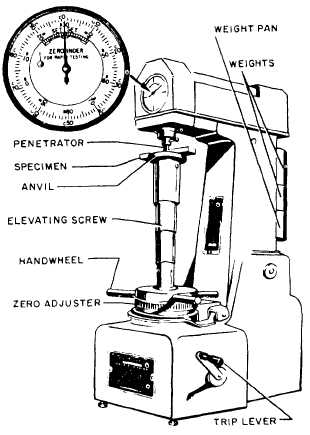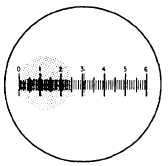Figure 1-25.—Brinell hardness tester.
Figure 1-26.—Microscopic view of impression.
BRINELL TESTER
The Brinell hardness tester, shown in figure 1-25,
uses a hardened spherical ball, which is forced into the
surface of the metal. The ball is 10 millimeters (0.3937
Figure 1-27.—Rockwell hardness tester.
inch) in diameter. A pressure of 3,000 kilograms (6,600
pounds) is used for ferrous metals and 500 kilograms for
nonferrous metals. Normally, the load should be applied
for 30 seconds. In order to produce equilibrium, this
period may be increased to 1 minute for extremely hard
steels. The load is applied by means of hydraulic
pressure. The hydraulic pressure is built up by a hand
pump or an electric motor, depending on the model of
tester. A pressure gauge indicates the amount of
pressure. There is a release mechanism for relieving the
pressure after the test has been made, and a calibrated
microscope is provided for measuring the diameter of
the impression in millimeters. The machine has various
shaped anvils for supporting the specimen and an
elevating screw for bringing the specimen in contact
with the ball penetrator. There are attachments for
special tests.
To determine the Brinell hardness number for a
metal, the diameter of the impression is first measured,
using the calibrated microscope furnished with the
tester. Figure 1-26 shows an impression as seen through
1-36





